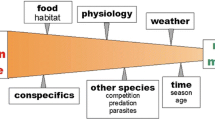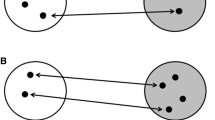Summary
The migratory behaviour of many bird species is currently changing, evidently in connection with global warming; in general there is a shift towards sedentariness. Because experimental studies indicate that all crucial aspects of migration are under direct genetic control, it is unlikely that the observed changes result from phenotypic plasticity. Equally improbable is the assumption of more numerous mutations in the same direction. Instead, the cause may well be rapid processes of selection and microevolution, which are demonstrable in the field and experimentally reproducible. An ideal initial situation for selection processes is partial migration. Such birds' genetic predisposition for both migration and nonmigration amounts to a kind of turntable, from which migrants, residents and partial migrants with various proportions of migratory and nonmigratory individuals can be selected. Partial migration is not only the most common life form among birds, but is a widespread type of behaviour that developed early in the evolution of plants and animals. The new bird migration theory postulates that birds either evolved partial migration very early or inherited it from avian ancestors, like other characteristics of migration such as compasses and fat deposition. In any case, birds thus possess a fundamental control mechanism which, depending on the environmental situation, permits the rapid emergence of phenotypic migrants or residents or transitional mixed populations comprising various combinations of migrant and resident individuals. This simple new theory allows us to dispense with the previous concept that migratory birds arose polyphyletically from nonmigrants by mutational “behavioural jumps” — a concept that cannot explain, for instance, the currently increased shift away from migratory behaviour.
Zusammenfassung
Gegenwärtig ändert sich das Zugverhalten vieler Vogelarten, offenbar im Zuge der globalen Klimaerwärmung, allgemein in Richtung Standvogelverhalten. Da nach experimentellen Untersuchungen Vogelzug in allen wesentlichen Bereichen unmittelbar genetisch gesteuert wird, ist unwahrscheinlich, dass die beobachteten Veränderungen auf phänotypischer Plastizität beruhen. Ebenso wenig wahrscheinlich ist die Annahme gehäuft auftretender gleichgerichteter Mutationen. Vielmehr dürften rasche Selektions- und Mikroevolutionsvorgänge zu Grunde liegen, die sich im Freiland nachweisen und im Experiment darstellen ließen. Ideale Ausgangssituation für Selektionsvorgänge ist der Teilzug. Er stellt mit genetischer Disposition für Ziehen und Nichtziehen eine Art Drehscheibe dar, von der aus schnell Zugvögel, Standvögel und Teilzieher mit verschiedenen Zug- und Standvogelanteilen selektiert werden können. Teilzugverhalten ist nicht nur die bei Vögeln häufigste Lebensform, sondern allgemein weit verbreitet und eine in der Evolution von Pflanzen und Tieren frühzeitig entwickelte Verhaltensform. Die neue Vogelzugtheorie postuliert, dass Vögel Teilzugverhalten entweder sehr früh entwickelt oder — wie andere Charakteristika des Ziehens wie Kompass-Systeme, Fettdepotbildung usw. — bereits von Vogelvorfahren übernommen haben. In jedem Fall besitzen Vögel damit einen fundamentalen Steuermechanismus, der je nach Umweltsituation die rasche Ausbildung von phänotypischen Zug- oder Standvögeln oder von übergangs-Mischpopulationen aus ziehenden und nicht ziehenden Individuen ermöglicht. Diese einfache neue Theorie macht die bisherige Annahme entbehrlich, Zugvögel seien polyphyletisch durch mutative „Verhaltens-sprünge“ aus Standvögeln entstanden, die u.a. die z.Z. gehäuft gerichtet auftretenden Änderungen des Zugverhaltens nicht erklären kann.
Similar content being viewed by others
Literatur
Able, K.P. & J.R. Belthoff (1988): Rapid ‘evolution’ of migratory behaviour in the introduced house finch of eastern North America. Proc. R. Soc. Lond. B 265: 2063–2071.
Berthold, P. (1996): Control of bird migration. London.
Berthold, P. (1999): A comprehensive theory of the evolution, control and adaptability of avian migration. In: Adams, N., Slotow, R. (eds.), Proc. 22 Internat. Ornithol. Congr. Durban, University of Natal. Ostrich 70: 1–11.
Berthold, P. (2000): Vogelzug — eine aktuelle Gesamtübersicht. 4. Auflage. Darmstadt.
Berthold, P., Helbig, A., Mohr, G., Pulido, F. & Querner, U. (1996): Aktueller Forschungsschwerpunkt: Vogelzug — moderne Phänomenologie und experimentelle Analyse der Steuerungssysteme und Evolutionsvorgänge. Jahrb. Max-Planck-Ges., 346–354.
Gwinner, E. (1996): Circadian and circannual programmes in avian migration. J. Exp. Biol. 199: 39–48.
Mayr, E. (1926): Die Ausbreitung des Girlitz (Serinus canaria serinus L.). J. Ornithol. 74: 571–671.
Peterson, R. T., Mountfort, G. & Hollom, P.D.D. (1993): Collins field guide. Birds of Britain and Europe. London.
Rappole, J. H. (1995): The ecology of migrant birds: a neotropical perspective. Washington.
Terrill, S. B. (1990): Ecophysiological aspects of movements by migrants in the wintering quarters. In: Gwinner, E. (ed.): Bird migration: the physiology and ecophysiology: 130–143. Berlin.
Winker, K., Escalante, P., Rappole, M. H., Ramos, M. A., Oehlenschlager, R. J. & Warner, D. W. (1997): Periodic migration and lowland forest refugia in a „sedentary“ neotropical bird, Wetmore's Bush-Tanager. Conserv. Biol. 11: 692–697.
Author information
Authors and Affiliations
Rights and permissions
About this article
Cite this article
Berthold, P. Vogelzug: eine neue Theorie zur Evolution, Steuerung und Anpassungsfähigkeit des Zugverhaltens. J Ornithol 142 (Suppl 1), 148–159 (2001). https://doi.org/10.1007/BF01651453
Issue Date:
DOI: https://doi.org/10.1007/BF01651453




